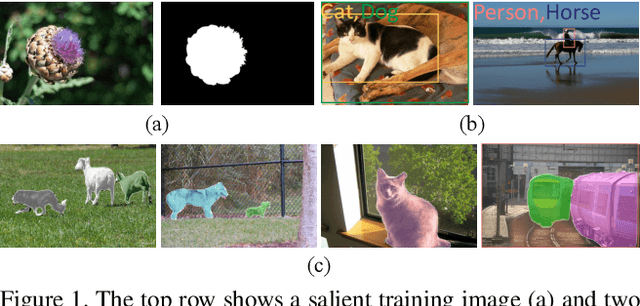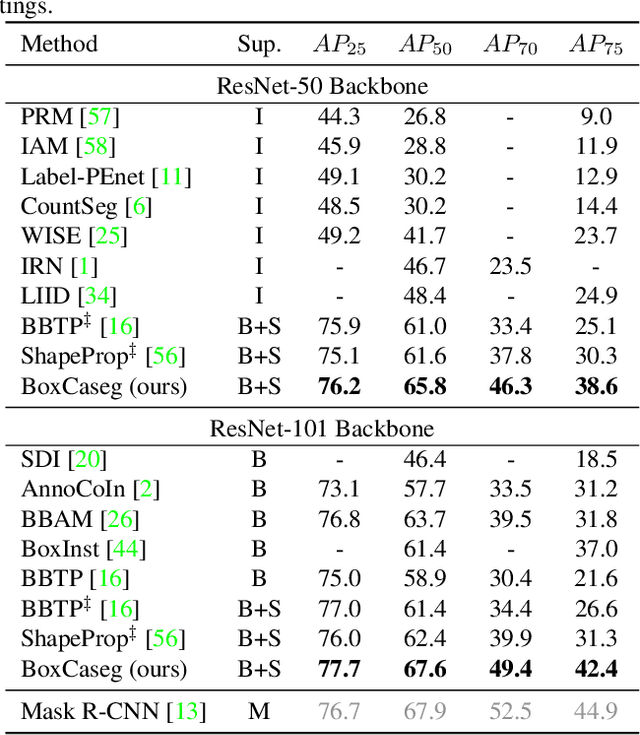Longjin Ran
GroundingSuite: Measuring Complex Multi-Granular Pixel Grounding
Mar 13, 2025Abstract:Pixel grounding, encompassing tasks such as Referring Expression Segmentation (RES), has garnered considerable attention due to its immense potential for bridging the gap between vision and language modalities. However, advancements in this domain are currently constrained by limitations inherent in existing datasets, including limited object categories, insufficient textual diversity, and a scarcity of high-quality annotations. To mitigate these limitations, we introduce GroundingSuite, which comprises: (1) an automated data annotation framework leveraging multiple Vision-Language Model (VLM) agents; (2) a large-scale training dataset encompassing 9.56 million diverse referring expressions and their corresponding segmentations; and (3) a meticulously curated evaluation benchmark consisting of 3,800 images. The GroundingSuite training dataset facilitates substantial performance improvements, enabling models trained on it to achieve state-of-the-art results. Specifically, a cIoU of 68.9 on gRefCOCO and a gIoU of 55.3 on RefCOCOm. Moreover, the GroundingSuite annotation framework demonstrates superior efficiency compared to the current leading data annotation method, i.e., $4.5 \times$ faster than the GLaMM.
ControlAR: Controllable Image Generation with Autoregressive Models
Oct 03, 2024



Abstract:Autoregressive (AR) models have reformulated image generation as next-token prediction, demonstrating remarkable potential and emerging as strong competitors to diffusion models. However, control-to-image generation, akin to ControlNet, remains largely unexplored within AR models. Although a natural approach, inspired by advancements in Large Language Models, is to tokenize control images into tokens and prefill them into the autoregressive model before decoding image tokens, it still falls short in generation quality compared to ControlNet and suffers from inefficiency. To this end, we introduce ControlAR, an efficient and effective framework for integrating spatial controls into autoregressive image generation models. Firstly, we explore control encoding for AR models and propose a lightweight control encoder to transform spatial inputs (e.g., canny edges or depth maps) into control tokens. Then ControlAR exploits the conditional decoding method to generate the next image token conditioned on the per-token fusion between control and image tokens, similar to positional encodings. Compared to prefilling tokens, using conditional decoding significantly strengthens the control capability of AR models but also maintains the model's efficiency. Furthermore, the proposed ControlAR surprisingly empowers AR models with arbitrary-resolution image generation via conditional decoding and specific controls. Extensive experiments can demonstrate the controllability of the proposed ControlAR for the autoregressive control-to-image generation across diverse inputs, including edges, depths, and segmentation masks. Furthermore, both quantitative and qualitative results indicate that ControlAR surpasses previous state-of-the-art controllable diffusion models, e.g., ControlNet++. Code, models, and demo will soon be available at https://github.com/hustvl/ControlAR.
EVF-SAM: Early Vision-Language Fusion for Text-Prompted Segment Anything Model
Jun 28, 2024



Abstract:Segment Anything Model (SAM) has attracted widespread attention for its superior interactive segmentation capabilities with visual prompts while lacking further exploration of text prompts. In this paper, we empirically investigate what text prompt encoders (e.g., CLIP or LLM) are good for adapting SAM for referring expression segmentation and introduce the Early Vision-language Fusion-based SAM (EVF-SAM). EVF-SAM is a simple yet effective referring segmentation method which exploits multimodal prompts (i.e., image and text) and comprises a pre-trained vision-language model to generate referring prompts and a SAM model for segmentation. Surprisingly, we observe that: (1) multimodal prompts and (2) vision-language models with early fusion (e.g., BEIT-3) are beneficial for prompting SAM for accurate referring segmentation. Our experiments show that the proposed EVF-SAM based on BEIT-3 can obtain state-of-the-art performance on RefCOCO/+/g for referring expression segmentation and demonstrate the superiority of prompting SAM with early vision-language fusion. In addition, the proposed EVF-SAM with 1.32B parameters achieves remarkably higher performance while reducing nearly 82% of parameters compared to previous SAM methods based on large multimodal models.
Weakly-supervised Instance Segmentation via Class-agnostic Learning with Salient Images
Apr 04, 2021



Abstract:Humans have a strong class-agnostic object segmentation ability and can outline boundaries of unknown objects precisely, which motivates us to propose a box-supervised class-agnostic object segmentation (BoxCaseg) based solution for weakly-supervised instance segmentation. The BoxCaseg model is jointly trained using box-supervised images and salient images in a multi-task learning manner. The fine-annotated salient images provide class-agnostic and precise object localization guidance for box-supervised images. The object masks predicted by a pretrained BoxCaseg model are refined via a novel merged and dropped strategy as proxy ground truth to train a Mask R-CNN for weakly-supervised instance segmentation. Only using $7991$ salient images, the weakly-supervised Mask R-CNN is on par with fully-supervised Mask R-CNN on PASCAL VOC and significantly outperforms previous state-of-the-art box-supervised instance segmentation methods on COCO. The source code, pretrained models and datasets are available at \url{https://github.com/hustvl/BoxCaseg}.
 Add to Chrome
Add to Chrome Add to Firefox
Add to Firefox Add to Edge
Add to Edge